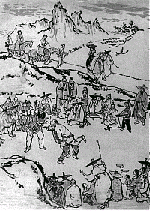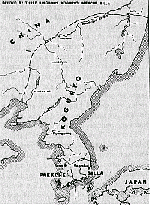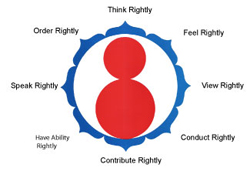Student Study Guide
- Respect – Showing Honor to others and oneself
- Humility – Not showing off
- Perseverance – Never giving up
- Self-control – Controlling the circumstances around you – not letting them control you
- Honesty – Telling the truth
to be friends with one another and to develop strength within our group.
We shall never fight to achieve selfish goals.
To develop wisdom and character are our ultimate commitments.
UNITE FOR RIGHT!"
- Loyalty to your country
- Respect your parents
- Faithfulness to your spouse
- Respect your brothers and sisters
- Loyalty to your friends
- Respect your elders
- Respect your teachers
- Never take life unjustly
- Indomitable spirit
- Loyalty to your school
- Finish what you begin
 Tae Kwon Do is not just training in kicking, punching and self defense. It is far more even than training in mental/physical coordination. A major feature of the art is the development of a certain spirit which carries over into all aspects of life. If there exists a means through which one could secure a stable, peaceful life, it would have to be based upon a harmony between oneself and nature. Do in Korean means "art," "path," "way," "way of life." It is the way in the universe. The philosophy of Tae Kwon Do has as its roots many of the tenets held by religious masters and devout laymen throughout history. The qualities can be traced back to the influence of Buddhism, and its aim of the "Mastery of Life." Buddhism, introduced to the Koguryo kingdom in China in 347 A.D., contributed greatly to the growth of the Korean martial arts. The focus of Tae Kwon Do philosophy is to offer a means by which the student can rid him/herself of the ego, or what Zen-Buddhists call "discriminating mind," in order to live in harmony with the universe.
Tae Kwon Do is not just training in kicking, punching and self defense. It is far more even than training in mental/physical coordination. A major feature of the art is the development of a certain spirit which carries over into all aspects of life. If there exists a means through which one could secure a stable, peaceful life, it would have to be based upon a harmony between oneself and nature. Do in Korean means "art," "path," "way," "way of life." It is the way in the universe. The philosophy of Tae Kwon Do has as its roots many of the tenets held by religious masters and devout laymen throughout history. The qualities can be traced back to the influence of Buddhism, and its aim of the "Mastery of Life." Buddhism, introduced to the Koguryo kingdom in China in 347 A.D., contributed greatly to the growth of the Korean martial arts. The focus of Tae Kwon Do philosophy is to offer a means by which the student can rid him/herself of the ego, or what Zen-Buddhists call "discriminating mind," in order to live in harmony with the universe.
At the core of this philosophy is the concept of 'duality' in nature. Duality refers to the interaction of opposing forces. Harmony is achieved when opposite forces are distributed equally, resulting in balance. When one force dominates however, discord is the result. For example, when an adversary uses positive (aggressive) energy, or in other words initiates an attack, the defender should use negative (yielding) energy to respond, by stepping aside to allow the energy of that attack to flow past harmlessly. In this manner, what was once hard (the assailant's attack) becomes soft (non injurious), and what was soft (the defender's passivity) becomes hard (an effective way to counter a potential dangerous assault), allowing balance to return.
 Ultimately, the philosophy of Tae Kwon Do seeks to bring students to a level of consciousness known as "Present Time." This occurs when one is completely in tune with oneself and nature to the degree that ones actions and reactions are always perfectly coordinated with the forces in life whether that be in the sparring ring, in a social setting or even when alone. Such a person cannot be made upset by anything it encounters in life. True masters of Tae Kwon Do are noted for their serene personalities, which stem from their living in Present Time.
Ultimately, the philosophy of Tae Kwon Do seeks to bring students to a level of consciousness known as "Present Time." This occurs when one is completely in tune with oneself and nature to the degree that ones actions and reactions are always perfectly coordinated with the forces in life whether that be in the sparring ring, in a social setting or even when alone. Such a person cannot be made upset by anything it encounters in life. True masters of Tae Kwon Do are noted for their serene personalities, which stem from their living in Present Time.
Every person is capable of coordinating him or herself with the forces in life more perfectly. By centering oneself and balancing the dual forces through living in "Present Time," students can begin to touch the true goal of all human life which is the aspiration to and application of perfection.
"Tae Kwon Do" Yeon Hee Park
 The roots of Taekwondo began over 2,000 years ago in Korea. The evolution of Taekwondo was a result of happenings throughout Korean history. Knowledge of this history is an important step in understanding Taekwondo.
The roots of Taekwondo began over 2,000 years ago in Korea. The evolution of Taekwondo was a result of happenings throughout Korean history. Knowledge of this history is an important step in understanding Taekwondo.
Early Koreans developed unique martial arts forms for unarmed combat to compliment their skills with weapons. First referred to as Su Bak, much later, Kwon Bup and finally, Tae Kyon, these forms used the body's natural weapons (i.e. hands, fists, feet, etc.).
During the 6th century AD, the Korean peninsula was divided into three kingdoms; Koguryo, Pakje and Silla. Koguryo was the largest kingdom, occupying the southern section of Manchuria and the northern section of the Korean peninsula. Pakje was situated along the Han River in southwest Korea. Silla was the smallest of the kingdoms and was located on the southeast tip of the Korean peninsula.
Archeological findings such as mural paintings from the Koguryo period, stone sculptures from the Silla period, and documents written in the Pakje period show techniques and fighting stances that were probably the first forms of Taekwondo. Silla eventually unified the kingdoms after winning the war against Pakje and Koguryo. The Hwa Rang warriors played an important role in this unification.
The Hwa Rang (translated Flower Youth) was an elite group of young noblemen devoted to cultivating mind and body and serving the kingdom of Silla. They had an honor code and practiced various forms of martial arts. The Hwa Rang's honor code is the philosophical background of modern Taekwondo.
Modern day Taekwondo was also greatly influenced by the Japanese invasion and occupation of Korea from 1909-1945. The Japanese suppressed Korean martial arts and culture. Japanese martial arts were introduced in Korea during this time. After the defeat of the Japanese and liberation of Korea in 1945, Korean martial arts masters wanted to eliminate Japanese influences. Discussions took place on how to unite the various new martial arts schools (or Kwans) & styles into a single style and national sport. In 1955 the name "Taekwondo" was chosen by the board of masters of the various Kwans. Unification of the Kwans began in the late 50's.
The spread of Taekwondo as a martial art and competitive sport continues today.
The following events took place in recent history and contributed greatly to the Taekwondo we currently know:
- 1965 – The Korea Taekwondo Association was formed
- 1973 – World Taekwondo Federation (WTF) created
- 1975 – General Association of International Sports Federations (GAISF) recognizes the WTF
- 1980 – International Olympic Committee (IOC) recognizes the WTF
- 1985 – Taekwondo adopted as a demonstration sport for the 1988 Olympic Games in Seoul, Korea
- 1992 – Taekwondo is an Olympic demonstration sport in Barcelona, Spain
- 1994 – Taekwondo selected as a full Olympic sport for the 2000 Olympic Games in Sydney, Australia
- Present – Taekwondo is the most widely practiced martial art in the world

Ji Do Kwan is one of eight schools of Tae Kwon Do.
The general translation of Ji Do Kwan is “way of wisdom” or “way of knowledge”.
Ji Do Kwan actions are unrestrained to allow more fluid movements unlike most other styles that emphasize ancient more rigid actions.
The Meaning of the Ji Do Kwan Symbol
The symbol of Ji Do Kwan is called an o-de-key. It is made up of three main parts. It contains three circles, each of which makes a whole within itself, with no beginning or end. Each of these emblematic circles represents a different aspect to students of Ji Do Kwan.
The large outer circle represents the universe holding inside all we know and all we need around us within its mighty realm. The larger circle inside represents our earth. The smaller circle represents the life on earth. When the circles are placed together we see contact between all three.
The Rose of Sharon is the Korean national flower with eight petals. Many say the Ji Do Kwan symbol represents this flower. The petals draw your eye to the center. Each petal represents an attitude. The number “8” is a number of balance and harmony, organization and personal success. Each petal represents one of the “Eight Manners of Solemnity”.
The colors red and blue have significance to the meaning of the Ji Do Kwan symbol. Red is the color of energy and power, courage and attention. Blue is for peace, calm and friendship. Placed together they create balance and harmony.


The World Tae Kwon Do Federation (WTF) quickly became internationally recognized after its foundation in 1973. In fact by 1980, it was recognized by the international Olympic Committee.
In 1984, Tae Kwon Do was sanctioned as a Demonstration Sport at the 1988 Summer Olympics in Seoul, South Korea, as Tae kwon Do is the national sport of Korea. Tae Kwon Do became a full medal sport at the 2000 Summer Olympic Games in Sydney, Australia.
The rules are regulated by the WTF; most Olympic sports are regulated by an external organization.